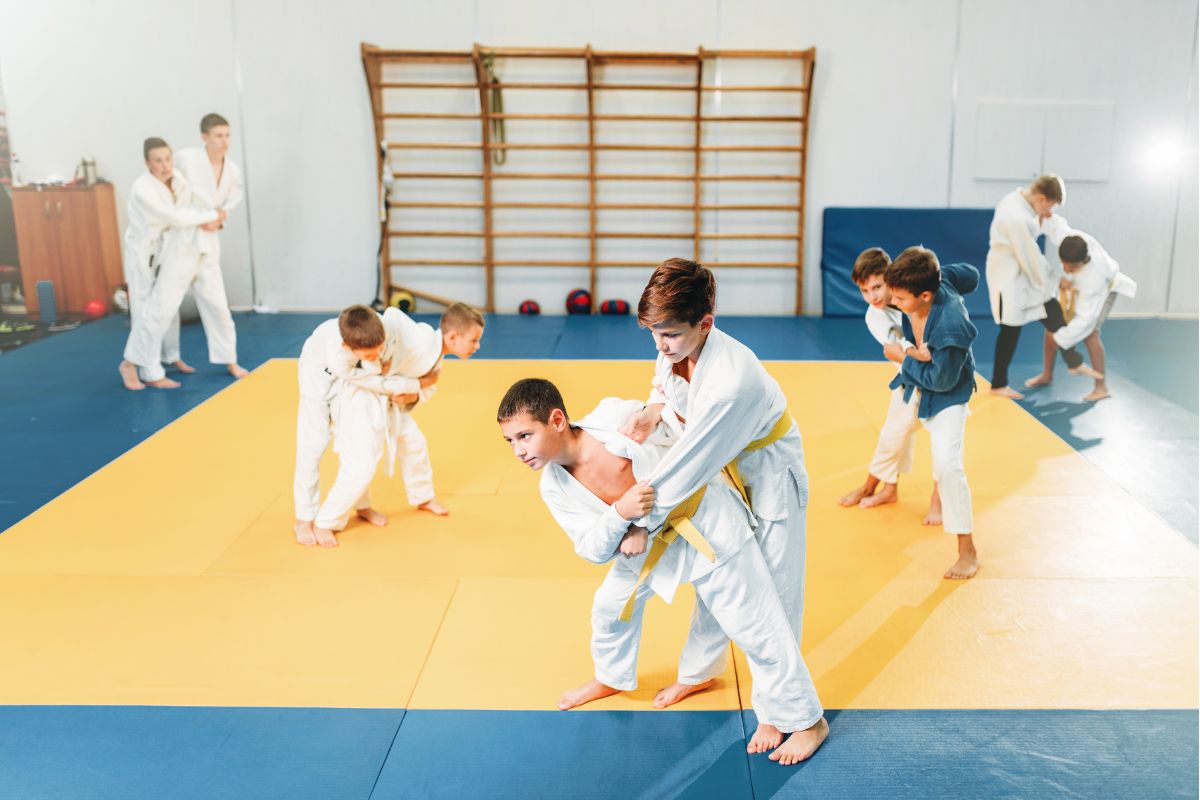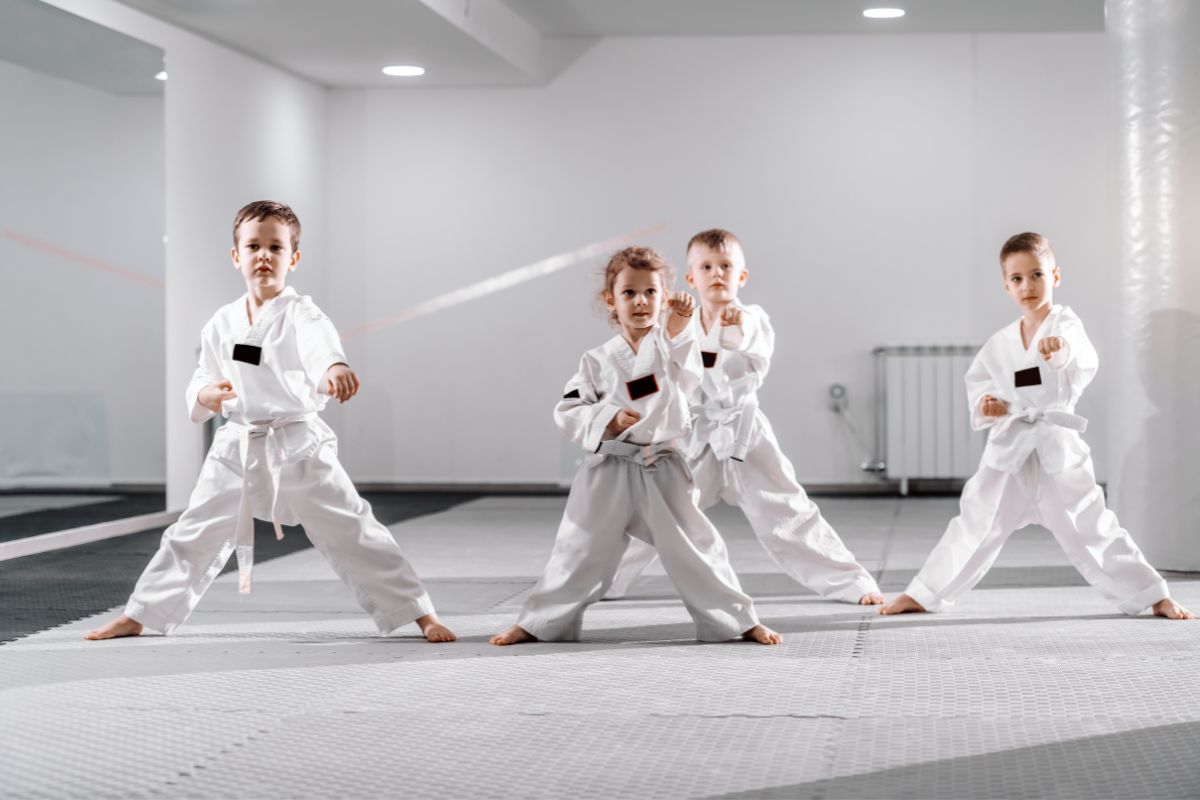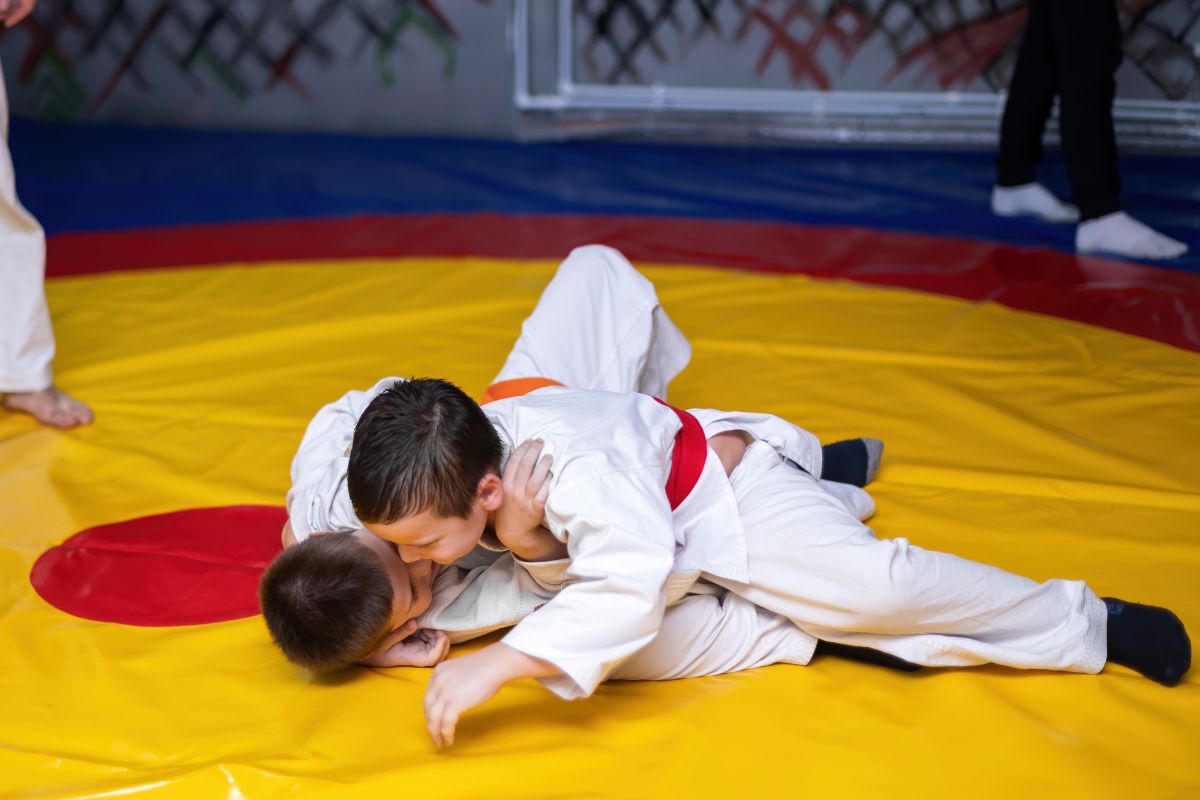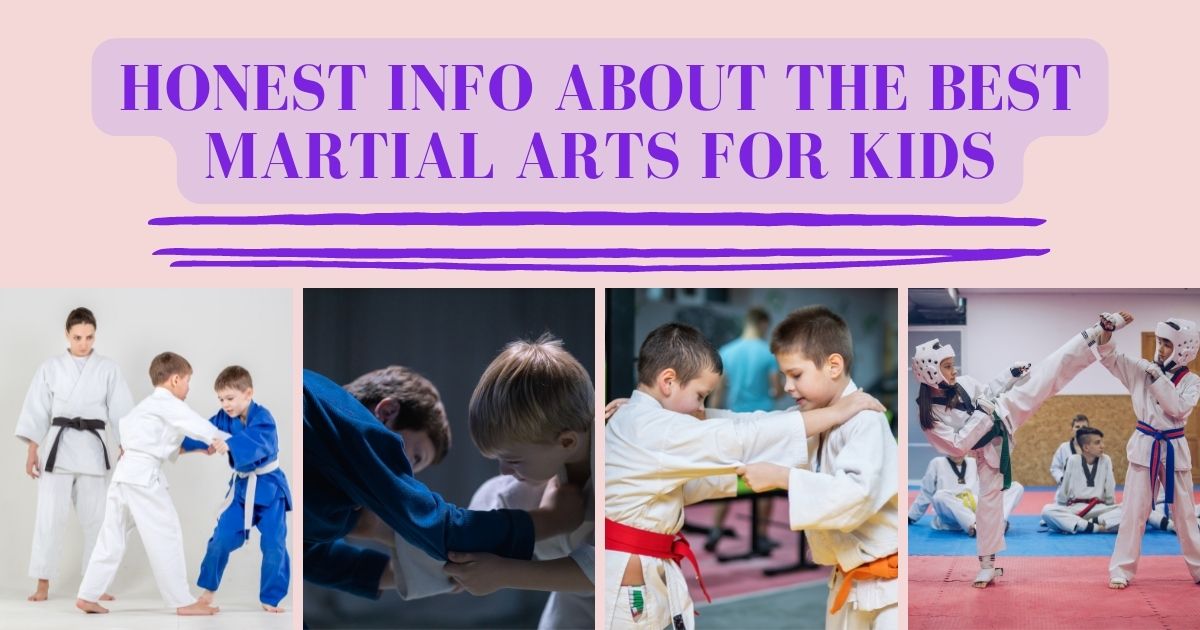Martial Arts for Kids
Martial arts help your youngster develop strength, self-confidence, discipline, and friendships. First, you need to select the best martial arts for kids. Identifying the best martial art for your child is challenging because so many options are available.
In this article, you will find the top martial arts for kids and learn the abilities your child gets from each style. This will help you pick the one that suits your child’s personality.

Why is MMA Good for Children?
Both children and adults can experience remarkable improvements in their physical and mental health via participation in martial arts. Your children will have a great time participating in these activities and learn valuable life skills such as self-defense, collaboration, discipline, and self-assurance.
Take a look at the many wonderful advantages of martial arts training for children. If you are still on the fence about whether or not to enroll your children in lessons for kids martial arts, these advantages will convince you.
Exercise
Your children will enjoy staying active and healthy by participating in martial arts and will have a great time doing it! Children have the opportunity to strengthen their coordination, reflexes, flexibility, balance, endurance, and agility.
They will also get a full-body workout. They will have more energy for school and other activities if they have a healthy body and active lifestyle. This will make them feel better in their day-to-day lives. It is also a wonderful alternative for children who do not enjoy participating in other sports.
Make Friends
Your children will have a terrific opportunity to meet other children and make new friends while learning kid’s martial arts. This is like they would while participating in a team sport. Your child’s ability to make new friends in class and encourage one another to perform, and improve, can be a powerful motivator for them to continue attending school.
Teamwork
Even though evaluation of the progress in kids’ martial arts is individual, the sport helps improve children’s ability to collaborate in groups. It provides them with common objectives to pursue and meet. When students reach a particular level in most forms of martial arts, they need to practice their skills on each other in a state known as sparring.
Students must learn how to cooperate because practicing and drilling together is more useful than practicing alone. Besides, they must treat one another respectfully and cheerlead and assist one another on their respective paths in the martial arts.
Self Defense
One of the most significant advantages of martial arts training for children and their parents is the development of the best self-defense for kids skills. Being a parent means taking on the responsibility of worrying about your child’s well-being whenever you cannot protect them.
Suppose you teach them self-defense skills through martial arts. In that case, Your level of anxiety will decrease, and your child will experience a greater sense of security in the world.
Discipline
It is not true that if you show your children how to block, kick, and punch that they will become more aggressive in their day-to-day lives. Studies show that participation in kids’ martial arts can help reduce violent behavior because of the emphasis on discipline and self-control in the sport. To develop discipline in your child, select the best martial arts for discipline.
Mindfulness
Practicing martial arts can have positive effects on one’s mentality. They can help your child develop into a well-rounded person by teaching them vital life skills such as mindfulness, patience, humility, and respect.
This helps your child grow positively in all aspects of life. It may even help children listen more carefully, feel less anxious, maintain concentration, and be resilient in adversity.
Self Esteem
Participating in a martial arts class can do wonders for a child’s self-assurance. Therefore consider signing up your child for the classes. They will not put your child under any pressure to evaluate themselves regarding how they stack up to others. Classes often center on the value of personal development.
Your youngster may benefit from beginning martial arts because it will make them feel more secure in themselves. As your child advances through the different belt levels at their rate, it is an excellent opportunity to build their self-esteem. You can do this by working towards and completing goals set for them in lessons.
Social Skills
Children participating in martial arts programs must interact with other students of varying ages and work together as a team. As a result, they will develop social skills by interacting with younger and older children.
They get the opportunity to interact with children from various diverse backgrounds, which gives them the chance to learn how to cooperate and understand how to behave in a team setting. This exposure fosters the early development of good social skills while providing opportunities for memorable interactions.
Resolve Conflicts
Children from various backgrounds attend the same school, so the instructors emphasize empathy, leadership, and cooperation with the students. This helps to resolve conflicts. Children will get the skills necessary to resolve disputes peacefully and collaborate with others.
Teaches Respect
In this session, the instructor expects the pupils to treat their coaches and other adults with power with respect by addressing them with titles such as “Sir” and “Ma’am.” They also become more humble and polite due to the lessons they learn.
Young kids get the same level of respect as adults, and they must show the same level of respect to their peers. Elite MMA believes in praise, encouragement, and positive reinforcement!
Education Against Bullying Is available in the anti-bullying curriculum at Elite child mixed martial arts. Parents need to practice alongside their children to assist their children in developing the “being” of a true martial artist. This includes humility, respect, honesty, integrity, and a strong work ethic.

Six Best MMA for Kids and Why They’re Great
Your child can choose from a wide variety of the most fun martial arts styles. Still, the type of martial art most beneficial to your child will depend on what you hope they will get from participating in the sport. Your child will get self-defense skills, increase their self-esteem, meet new friends, and learn discipline no matter the activity you decide to enroll them in.
If your child fails to respond well to the first form of treatment that you try, you can always try another type. If your child has an interest in having a more rounded experience, there is also mixed martial arts for kids they can do. Make it a point to investigate the various educational opportunities available in your region.
This will help you locate the institution that contributes most to your child’s development.
Every type of martial arts has its distinctive approach and specific advantages.
Karate
Karate is one of the best martial arts for toddlers. Many people practice it all over the world. It translates to “empty hands” in Japanese. It began as weaponless self-defense in Okinawa, Japan, after the prohibition of guns. Thus, karate is an excellent choice if you want to educate your children on skills in self-defense.
One’s self is the true adversary in traditional karate. The teachings place a significant emphasis on spiritual growth, self-control, patience, and discipline. This helps to assist students in becoming masters of themselves. Your child will learn balanced, full-body motions in karate.
Training will focus on blocks, blows, punches, evasions, and kicks to assist them in counter-striking opponents. Karate is a Japanese martial art. Kihon (also known as “basics”), Kata (often known as “forms”), and Kumite (sometimes known as “sparring”) are the three fundamental aspects of karate.
Your child will study from white to black belt (sparring) as they advance in rank. Karate lessons for children are available in every state for children of different ages. Karate for 4-year-olds is also open. So as soon as you choose the dojo that’s best suited to meet your needs, you’ll be able to start teaching your offspring the art in no time.
Tae Kwon Do
This is one of the best martial arts for teens and other children. Much like Karate, Tae Kwon Do strongly emphasizes cultivating patience and discipline. It is like a style of living that teaches unification of the body, mind, and life and improves one’s soul and life by training the body and mind to a higher level.
Tae Kwon Do comes from the Korean phrase “the way of the foot and the fist.” Compared to karate, it emphasizes leg techniques and kicks more. Therefore, if your child has an interest in learning quick kicks with a lot of detail, Tae Kwon Do may be the greatest option for them to pursue.
Students will still study blocks, takedowns, throws, punches, joint locks, and attacks, even though a significant emphasis is on the legs. In addition to being one of the most popular forms of martial art among adults, Tae Kwon Do is also one of the safest forms of martial art for children as young as three years old.
Tae kwon do, like other forms of martial arts, has the potential to provide your child with a comprehensive foundation in both physical and mental growth. Your child’s capacity to concentrate and recall things will enhance as a result of training in Tae Kwon Do because of the intricate moves that define the art.
On a physical level, not only will they learn how to manage their body, but they will also improve their fitness levels, gain strength, and become more flexible. It will expose your child to regulations and learn how to follow directions as a result of all of this, which will improve their health.
Children who learn to respond and adhere to their instructors and classmates appropriately develop respect and courtesy, which are further socioemotional benefits of martial arts training.
In addition, Tae Kwon Do focuses significantly on cooperating with others, which helps students improve their social and relational skills. As a consequence of this, one may experience increases in self-respect, self-confidence, and esteem.
Wrestling
There is evidence that wrestling is a popular practice in Ancient Egypt, making it one of the world’s oldest types of combat sports. Wrestling is a sport that children of any size or height can train in because several styles cater to each individual’s physique.
Wrestling is a grappling-focused contact sport that pits competitors against one another. Your child will learn clinch combat, throws, takedowns, joint locks, and pins when they enroll in wrestling classes.
Because it is one of the more challenging martial arts, both physically and psychologically, it will help your children develop excellent core strength, cardiovascular fitness, perseverance, and self-assurance.
Wrestling is frequently a competitive activity, which has the additional benefit of teaching children accountability. This is because children can take credit for their victories and understand that no one else is to blame for their defeats when they participate in wrestling.
Children as young as five or four can start wrestling, although the age at which they can begin wrestling can vary depending on their attitude. Children who start wrestling in a competitive setting at this age are more likely to experience burnout by the time they are 12 years old.
This is because they focus on winning rather than truly enjoying the sport and having fun. Suppose you decide to send your child to a wrestling school. In that case, you should delay entering them into competitions until a later stage in their training so that they can first develop a passion for the sport.
Brazilian Jiu-Jitsu
Brazilian Jiu-Jitsu is often one of the most effective martial arts for self-defense. This is because it teaches you abilities that you can employ against opponents who are larger and stronger than you.
Brazilian Jiu-Jitsu does not rely on strength or force. It provides smaller competitors an opportunity to defend themselves. Jiu-Jitsu, also known as Brazilian Jiu-Jitsu, is a grappling art emphasizing control of distance and leverage, positioning, submissions, and leverage over striking and kicking.
Jiu-Jitsu translates to “gentle method,” One of the primary focuses of martial art is instructing pupils on applying the appropriate amount of force to escape sticky situations. By developing their flexibility, your children will learn how to use their legs to dominate their opponent and get out of a tough position.
Your children will learn to use flexibility to get out of difficult positions. The techniques taught in Brazilian Jiu-Jitsu originate from Japan. Samurai warriors were employing it in self-defense on the battlefield.
Eventually, it found its way to Brazil, where it developed for several years to the point that the tactics became effective against physically weaker and smaller opponents. It should be no surprise that it is rapidly becoming one of the most popular martial art forms.
Jiu-Jitsu is an excellent kind of self-defense since its techniques are effective even against larger and stronger opponents.
Muay Thai
Muay Thai, which translates to “Thai boxing,” is often regarded as the most effective striking martial art in the world. Because it is one of the more violent forms of martial arts, some parents choose not to sign their children up for Muay Thai classes because of the stigma associated with the practice.
However, schools place a significant emphasis on teaching students that they should not use the abilities they get for any purpose other than in the classroom or in self-defense. Muay Thai is a form of Thai children’s martial arts that focuses on close-quarters combat and utilizes the entire body as a weapon.
In this, you protect yourself using eight different points of contact. This act has the name “the art of the eight limbs.” The hands transform into a sword, the shins and forearms become armor, the elbow becomes a hammer, and the legs and knees transform into an ax.
Muay Thai is one of the forms of martial art that is easier to learn. It teaches an effective stand-up striking style that does not involve excessively complicated movements that your child needs to memorize.
Despite how fancy this sounds, Muay Thai is also one of the easier forms of martial art to learn. In addition, it combines striking methods with grappling techniques in a fluid and seamless manner.
Aikido
Aikido is one of the less violent kinds of children’s martial arts. Therefore it is a good choice to study if you are seeking non-violent forms of martial arts for toddlers. Since it is not very effective against other individuals who are training in martial arts, it does not have the best reputation for use in self-defense.
As a result of its great emphasis on wrist locks and regulating arm direction, it is effective for usage against those who are aggressive, untrained, and lack control. Young children who have trouble concentrating in more advanced forms of martial arts may benefit greatly from taking Aikido as their first form of martial arts training.
It is advisable for people who study Aikido to also learn another martial art on this list later in their lives. This is to help in the development of more effective skills for self-defense.
Suppose your children find that they do not enjoy the first style of martial arts they try. In that case, many other martial arts styles are appropriate for children that you may want to investigate. These styles include Kung Fu, traditional fencing, mixed martial arts, Judo, and Tai Chi, among others.
You might even enroll in martial arts classes with your child, whether it be your daughter, son, or both. Now that you have the options to choose from, you may be wondering; how do martial arts help children?
Martial arts can reap a variety of benefits from training in many forms. Whichever style of martial art you decide is best for your children. They will benefit from participating in some martial arts.
These benefits come in addition to the development of core muscle groups. Every form of martial art emphasizes the importance of developing both self-discipline and self-confidence. As a result, they will teach children these vital life qualities and others such as respect, honor, and mental fortitude to the younger generation.
Participating in martial arts lessons can also assist children in developing social skills, forming friendships through interaction with other students, and sharing mutual interests.
You may also be asking; what Is the ideal age for a child to start martial arts? The minimum age at which a child can begin training in a particular martial art depends on that specific art’s mental and physical demands. Some martial arts styles are simpler to learn than others for youngsters. In contrast, others present unmanageable difficulties for children of very early ages.
For some forms of martial arts, children as young as three years old can begin training. However, for others, children need to be a little bit older. Most children start training in martial arts such as Karate and Brazilian Jiu-Jitsu between the ages of four and five.
However, due to the rigorous physical requirements of Taekwondo, most children cannot begin training in this art until they are eight years old or older.
When it comes to children, the age at which they begin training in martial arts depends on the instructor who teaches the class. If the teacher feels confident beginning instruction with a child at a younger age, then the minimum age that the instructor establishes as a reasonable starting point is appropriate.
Other important questions are: what is the safest martial art for my child, and do martial arts classes make children violent? While all forms of martial arts carry the potential for injury, some are far less risky than others. The forms of martial arts that do not involve weapons or throwing punches and kicks at an early stage are the safest for children.
Brazilian Jiu-Jitsu is frequently cited as the type of martial arts deemed the most appropriate for children. This is because it places a greater emphasis on grappling and submissions than on striking or weapons,
Because beginners in Karate and Aikido do not engage in sparring during the early stages of their training, these martial arts are also excellent choices for youngsters because they provide a low risk of injury.
Many parents fear that a child would become more aggressive due to training in martial arts. It is a well-established fact that participation in a martial art does not make a child more aggressive or violent. Martial arts training helps lessen these negative behaviors in young children and teenagers.
Because martial arts emphasize discipline, perseverance, and self-control, martial arts lessons can help minimize aggressive behavior and violence. Instead of teaching children or other pupils how to hurt other people intentionally, martial arts teach them how to protect themselves from injury.
Martial arts students should never engage an opponent outside of the classroom for any reason other than self-defense.

The Final Say
Kids can gain a lot of advantages from participating in martial arts. It helps them improve and maintain their physical health while teaching them vital life qualities like perseverance and self-control. Some forms of martial arts are better for adults than children. You can begin those for children when your child is as young as three years old.
Karate, Taekwondo, and Brazilian Jiu-Jitsu martial arts are excellent choices for children. They do not include the use of weapons. They perfectly adapt to children’s strength, mental capacity, and physical ability.
When searching for a place to study martial arts, it is important to look for a school that maintains high cleanliness standards and ensures that the training equipment and locations are suitable for students of all ages and are safe to use.
Make sure your child would have fun participating in these types of classes and that you are comfortable with the instructor’s teaching style before enrolling them. Taking part in martial arts lessons together as a family is an excellent way to join in a sport or activity you all like doing together.

